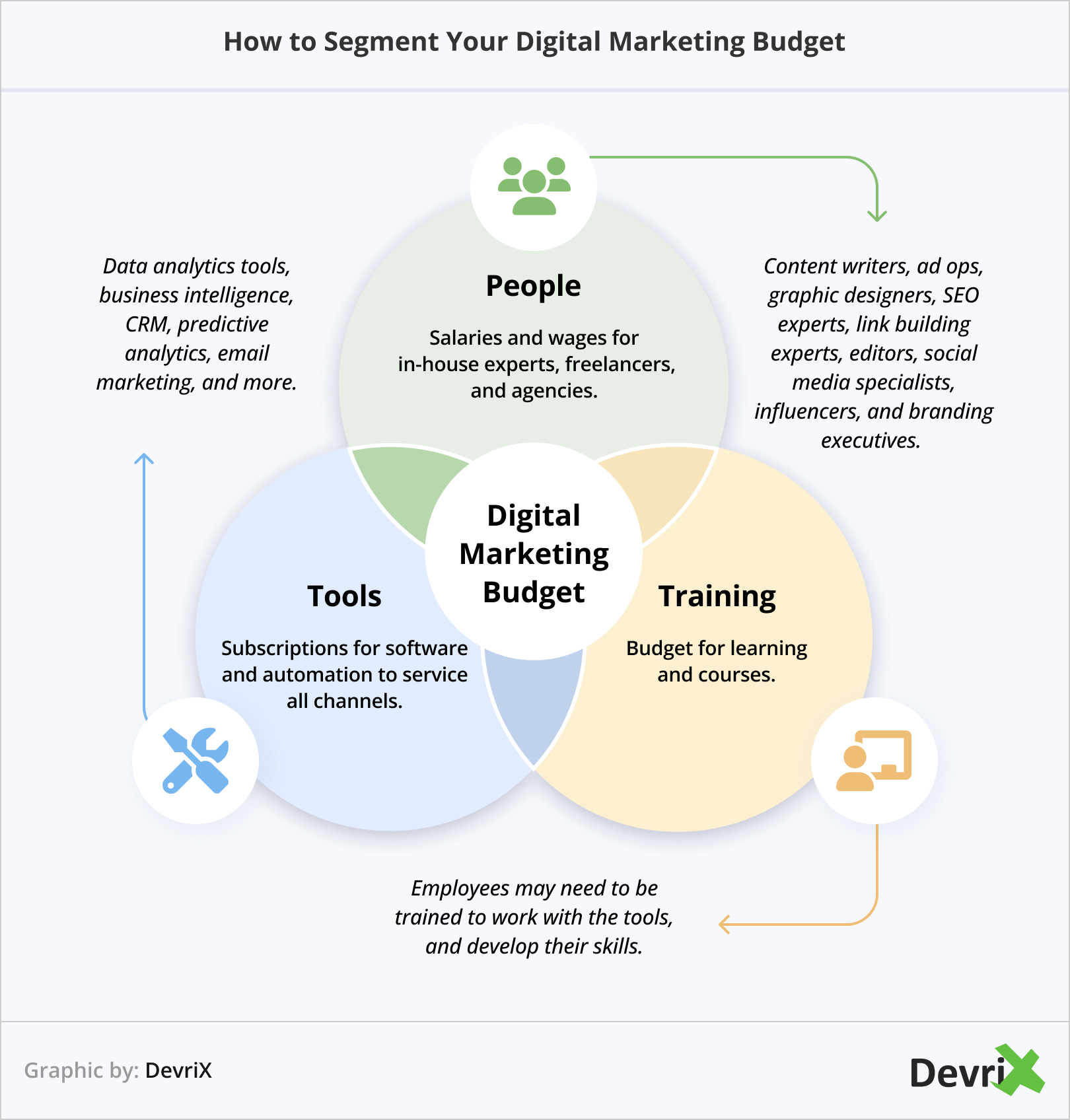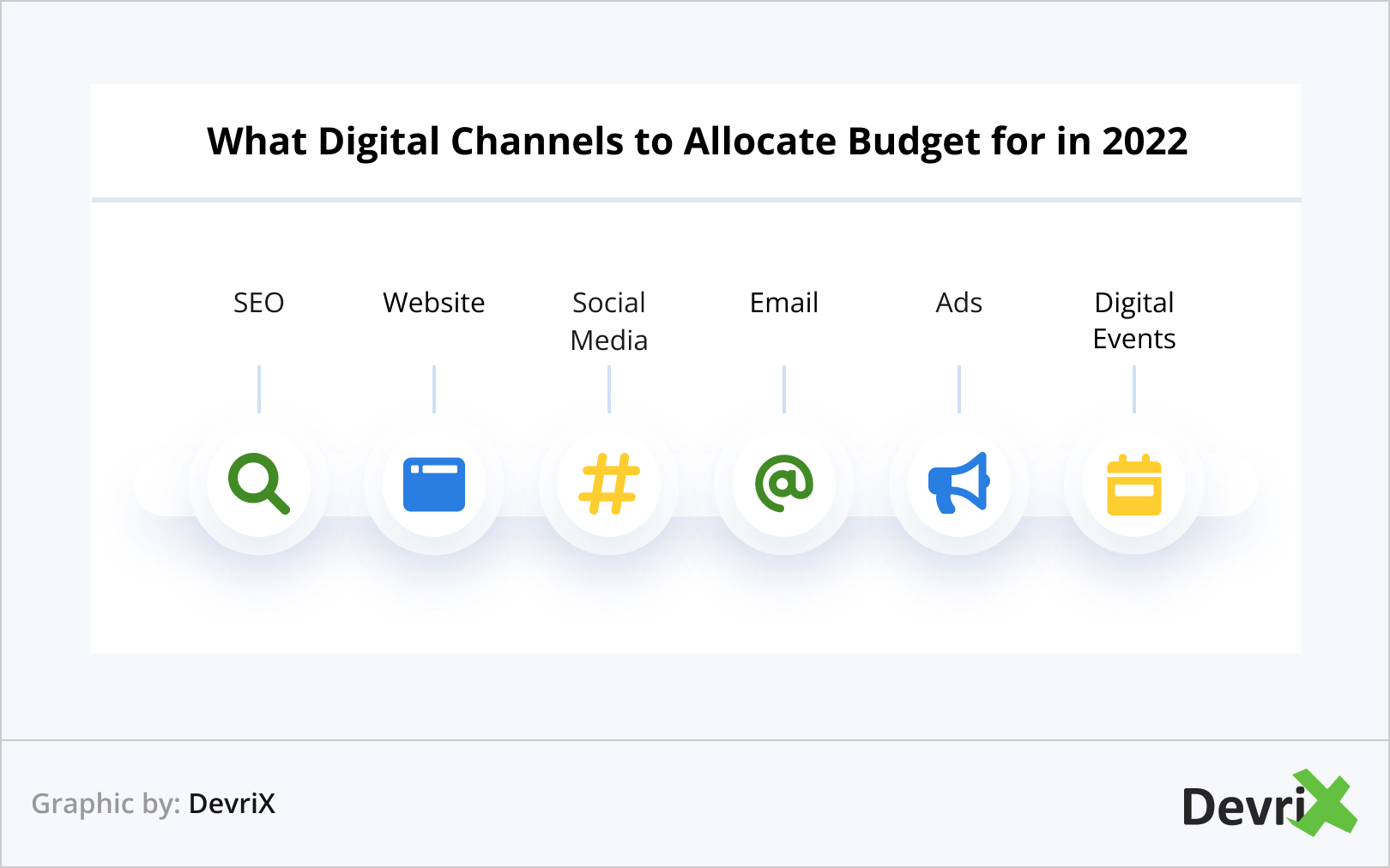At the end of every year, companies calculate their bottom line and plan their finances for the upcoming period. This includes, amongst other things, figuring out their digital marketing budget and setting a course of action for future inbound and outbound activities.
While, in the past, many companies neglected their digital presence and relied exclusively on traditional marketing and business models, things have changed. The pandemics have pushed people to spend more time online than ever before and, as if overnight, our lives have become digitized. A fact that, even when things get back to normal, will remain as part of our lives – not only out of necessity, but out of convenience.
This now means that for a business to remain relevant, stay in touch with its clients, and even grow in a recession, it has to have a solid digital marketing plan. Furthermore, management needs to allocate enough budget, and properly distribute it amongst the pertinent activities.
In this article, we’ll provide actionable tips and best practices on how to manage your marketing budget and make the best of it in 2022. Read on to find out!
1. Analyze Marketing Performance and ROI for Past Periods
If you are just starting out with your digital marketing strategy, you can skip past this part and research industry benchmarks instead. This will give you an idea how companies similar to yours approach distributing their budgets, what results they find satisfactory, and what return on investment (ROI) they consider sufficient.
However, if you already have experience with digital channels, the first thing you should do is to step back and analyze your annual reports.

Here’s what to focus on:
- Attribution Modeling. Attribution modeling and conversion tracking are possibly the best ways to understand the ROI and the performance of different marketing channels. They provide insight into how well your digital marketing budget has been distributed and whether it is, or was, in line with your business goals.
- Customer Journey Maps. When you create customer journey maps, you should not only focus on not only the present, but consider the future as well. This enables you to analyze what the conversion path looks like right now, and compare it to how you would want it to ideally be. Silos in your digital marketing strategy show where you need to allocate more budget.
- Analyze Customer Behavior. Monitoring customer behavior can show you how people interact with your brand, what makes them engage, which channels they prefer, what steps they take before they convert, and so forth. By analyzing this information, you can identify trends and patterns, and figure out behavior changes in a timely manner. This will enable you to align your marketing message approach to your customer’s profile and actions, and increase the ROI of your strategy.
However, while the ROI of digital marketing may be easily monitored, keep in mind that most algorithms monitor a limited period of time. Which means that the overall efficiency of your marketing channels isn’t completely trackable. Of course, you shouldn’t keep pouring money into low performing streamlines, but you should investigate whether or not the channel is the issue, or your strategy.
Also, consider exploring different attribution models to make sure you’ve identified how each touchpoint contributes to conversions. To that end, you have to also take into account the goals of the campaign and how well they are met.
In addition, how one channel performs, in one campaign, is not illustrative of its overall potential. To reach the right conclusion, always make sure to conduct a holistic analysis, and correlate different factors. This way, you will be able to accurately estimate how past KPIs can be relevant in future activities, and distribute your budget properly.
2. Update Your Buyer Personas
Buyer personas are semi-fictional personifications of a business’s customer profiles. When building them, companies conduct market research to understand who their customers are, what their needs are, what obstacles they face, and so on.
Using this information, the business can then target their audience accurately, and make sure their marketing message is on point.
However, the market does change over time, and so should your customer’s status, habits, and preferences. To make sure your marketing strategy remains relevant, you should regularly update your persona profiles. This allows you to better allocate your budget so that you meet the customers needs, and maximize the impact of your efforts.
3. Define Your Digital Marketing Goals for the Upcoming Year
Once you’ve done the preliminary work, it’s time to focus on the future, and define your marketing goals for the upcoming year.
As mentioned, your digital marketing plans should align with your business objectives. What you focus on depends entirely on the specifics of your company and what you want to achieve – growth, brand awareness, expansion to new markets, more sales, etc.
To estimate how much these will cost you, you’ll need to build a strategy. Once you break down your goals into objectives, you can plan the campaigns, and list what actions need to be taken to implement them. Calculating the expenses involved in each activity and adding them up will give you an idea of your digital marketing budget for the year.
However, in a dynamic market environment, you must be ready to be flexible with your strategies and be quick to modify your campaigns so that they resonate with the ever changing user behavior.
It’s good practice to divide your goals into four quarters (Qs) and continuously monitor each one’s performance. At the end of each Q, you can analyze the reports and adjust the strategy as per the results.
4. Decide How Much of Your Budget You Will Delegate to Marketing
Each business decides how much to spend on marketing depending on their individual goals and finances. However, on the average, companies in the US reinvest between 8.6-13.2% of their revenues into their marketing budgets. How much money you will allocate and how much you will spend, depends on your strategy for the upcoming year, and, most of all, on how well you plan your spendings.

Small businesses and companies that have little experience with digital platforms usually spend more on marketing because they have difficulties optimizing their budget. However, if they adopt a data-driven approach, instead of relying on hunches and assumptions, they can improve efficiency, reduce their expenses, and increase ROI.
5. Segment What Your Digital Marketing Budget

When planning how to allocate budget for digital marketing, it’s a good practice to start with listing all the items that add up to your expenses. These involve the following:
- People. Salaries and wages for in-house experts, freelancers, and agencies. These may include content writers, ad ops, graphic designers, SEO experts, link building agents, editors, social media specialists, influencers, and branding executives.
- Tools. Subscriptions for software and automation to service all channels. These may include data analytics tools, business intelligence, CRM, predictive analytics, SEO tools, social media scheduling software, email marketing, and more.
- Training. Budget for learning and courses. Employees may need to be trained to work with the tools, developing their skills, etc.
Knowing how much these cost, you will not only help you properly distribute your budget, but will also be useful in calculating important KPIs, such as customer acquisition costs, monthly and annual revenue, average revenue per user, and so on.
6. Choose to Proper Digital Marketing Channels
Nowadays, the best marketing strategies are omnichannel. This, of course, doesn’t mean that you have to distribute content on all your channels just for the sake of it. Instead, you should find out where your customers spend the most time, and what streamlines bring in the most engagement and conversions, and focus your efforts there.
As mentioned, it’s a good practice to regularly audit your channels’ performance and if a platform doesn’t work well for your business, you should either rethink your strategy or redistribute your budget.
In addition, you should research upcoming trends to see what type of content people and search engines are looking for, and invest in it.

Here are the most prominent channels to allocate budget for in 2022:
SEO
Even if your SEO strategy hasn’t delivered the desired results yet, you shouldn’t give up on your efforts. Search engine optimization is a waiting game and sometimes it requires time for the results to be evident.
SEO tools subscriptions may be costly, but paid solutions usually have far more options than free ones and therefore, they can give you a competitive advantage. Furthermore, industry trends are always changing and you may need to invest in courses and e-learning to upgrade your team’s skills.
However, if you think that you’ve done everything right but still see no changes in your ranking, consider hiring an SEO professional or agency to help you identify and fix any issues.
Website
A modern-looking, fast, responsive, and functional website is a must in 2022. New customers more often than not judge your brand based on the user experience your website provides, and, to make an impression, it should be flawless. Furthermore, website performance is not only important for people, but it matters to Google’s bots as well.
Depending on how large your website is, maintenance, migrations, and speed optimization can add a significant amount to your budget. However, these are all worth it, and with a professional touch your website can become the main revenue source of your business.
Social Media

Social media has proven itself as a beneficial channel for both B2C and B2B companies. However, to ensure that it delivers, you should hire dedicated experts to maintain your profiles and encourage engagement. If your operation is large and has many brands under its umbrella, you may even have to hire a whole team.
Also, tools that help you repurpose content for different platforms, optimize ads, and monitor what’s the word on the digital street don’t come cheap. But the price is usually worth it, because they can help you boost performance and optimize your budget.
Furthermore, when planning your social media budget, you need to consider how often to launch ads and sponsored posts, and how much these will cost.
Email marketing is a robust and reliable channel that can easily be automated for increased efficiency and personalized user experience.
Aside from automation tools, you need to provide a budget for an email expert to configure all your drip campaigns, manage processes, and coordinate the teams responsible for the different elements of the email, including copy, design, landing pages, and so on.
Ads
PPC, social media, retargeting, and display ads, and banners are a large investment, but, if optimized properly, can contribute greatly to a business’s revenue.
Aside from the budget for publishing the ads, you should consider what tools enable you to boost performance and maximize engagement. Also, you may need a dedicated ad expert or a digital marketing agency to handle ads optimization for better efficiency.
Events
Digital events have become more relevant in the past few years and even when offline marketing happenings, such as trade shows and seminars, are back, the digital format will remain relevant. It not only offers versatility and convenience, but can be of great benefit for lead generation, and brand reputation.
By putting aside a budget for both organizing and attending events, you can work on your company’s image as an industry thought-leader, grow your professional network, and boost awareness.
7. Leave Budget Margin
It’s a good practice to make provisions for unexpected expenses and investments, especially in the dynamic times we live in. Marketing is the main communication medium between brands and the customer, and you should be ready to respond to your audience’s needs in any way possible.
This may involve making donations, supporting causes that your audience cares about, employing an environmentally friendly approach, and taking a stance when it most matters.
Furthermore, digital marketing is strongly dependent on technology, which makes it an ever-changing field. This means that new technology, emerging trends, and innovative solutions may appear over the year and if you don’t have a budget margin, you may not be able to take advantage of those.
8. Adopt a Data-Driven Approach

One of the things we love most about digital marketing is that it provides a hands-on approach. It enables you to monitor performance in real-time, and make immediate adjustments to your strategy. This provides businesses with a great advantage that allows them to fine-tune their budgets throughout the year.
Adopting a data-driven approach to your digital marketing efforts means that you should constantly track the information your tools provide, analyze performance, and look for ways to improve.
In other words, even if your judgment at the beginning of the year when you were allocating your budget was off, you can make changes and correct any issues at any moment.
Relying on data makes your business resilient to market shifts, customer behavior changes, and economical factors. By being agile and changing your priorities to respond to these new events, you can keep your company on top of marketplace trends, and remain relevant.
Bottom Line
Digital marketing provides businesses with access to the largest market there is – online users. To take full advantage of the benefits this offers, companies have to base their decisions on research and data, and allocate their budget accordingly.
With an omnichannel strategy in place and the experts and tools to implement it, businesses can engage their customers, build meaningful connections, and improve their online presence. As a result, they can improve their bottom line, and grow.




